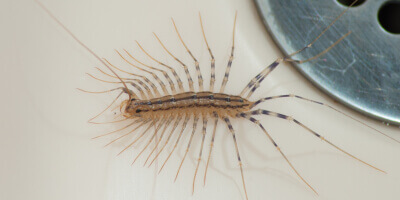Centipede Facts & Information
Everything you need to know about centipedes
WHAT DO centipedes LOOK LIKE

Centipedes are elongated, flattened arthropods with numerous legs – one pair per body segment. They are predaceous on many different arthropods including insects. Although all centipedes have poison glands and the means to inject their venom, bites are infrequent and normally do not cause more than temporary, localized pain. Unless you’re their prey. Then it’s fatal!
The house centipede adult has 15 pair of legs with the last pair (on adult females) nearly twice the length of the body, which is one to one and one-half inches in length. This gives the centipede an overall appearance of being from three to four inches in length (including legs and antennae). The legs are banded light and dark, and the body is a dirty yellow with three longitudinal, dark stripes. Newly hatched larvae (rarely seen) have four pair of legs. During the next five larval molts, the centipedes will have 5, 7, 9, 11, and 13 pairs of legs. On the next molt the centipede is considered an adolescent and will have 15 legs during each of the next four molts – when it becomes an adult.
The house centipede adult has 15 pair of legs with the last pair (on adult females) nearly twice the length of the body, which is one to one and one-half inches in length. This gives the centipede an overall appearance of being from three to four inches in length (including legs and antennae). The legs are banded light and dark, and the body is a dirty yellow with three longitudinal, dark stripes. Newly hatched larvae (rarely seen) have four pair of legs. During the next five larval molts, the centipedes will have 5, 7, 9, 11, and 13 pairs of legs. On the next molt the centipede is considered an adolescent and will have 15 legs during each of the next four molts – when it becomes an adult.
Where do centipedes live
Most centipedes can be found under boards, logs, rocks, and other protected, damp locations outside. These centipedes are of little concern to homeowners and business owners but are indicative of a larger pest control issue. Centipedes can be found in many buildings throughout the United States. It can’t survive winters outdoors, but readily reproduces in heated structures like your home or business.
Locations within structures that have been known to provide safe harborage for house centipedes include beneath concrete slabs, inside cement block walls, in floor drains without water traps, under and in cardboard boxes that are stored on slabs, and in any damp, cool location like crawl spaces and basements. Centipedes enter the house through expansion cracks, around sump pump openings, or other breaks in slab integrity. They can also enter through uncapped blocks, missing mortar between blocks, and around pipes where they pass through the walls.
Locations within structures that have been known to provide safe harborage for house centipedes include beneath concrete slabs, inside cement block walls, in floor drains without water traps, under and in cardboard boxes that are stored on slabs, and in any damp, cool location like crawl spaces and basements. Centipedes enter the house through expansion cracks, around sump pump openings, or other breaks in slab integrity. They can also enter through uncapped blocks, missing mortar between blocks, and around pipes where they pass through the walls.
How did I get centipedes
Known for killing other pests, house centipedes will enter your home or business because they’re on the hunt for other home-invading bugs to feast on. Generally, they will mind their own business and will help to banish roaches, moths, flies, silverfish, and termites around your home. House centipedes love damp and dark areas, so buildings with moisture could be a reason they are there. Many people find them in their wardrobes, bathrooms, cellars, bathtubs, and sinks. Remember, they’re attracted to other pests and will do everything they can to find them. Centipedes may also be drawn to the warmth of your bed, especially if you have a bed bug infestation. To avoid this, clean your mattress and bedding often. They can squeeze under doors and in the smallest of cracks. They can even come in on packages. Most likely, it’s nothing you’re doing that’s attracting them!
what Problems do centipedes cause
Because of their secretive nature, scary appearance and darting motions, people typically fear centipedes. Centipedes are most active at night because they shy away from light and are nocturnal hunters. Their presence often points to further pest problems, as they feed on ants, spiders, and crickets. While centipedes are not dangerous, their fast movements and alarming appearance make many people uneasy.
Even though venom from most species of centipedes is not powerful enough to affect larger animals and humans, the pests aren’t welcome in homes and businesses in New York, New Jersey, Connecticut, Delaware, and Pennsylvania. So, the major problem they cause – fear.
Even though venom from most species of centipedes is not powerful enough to affect larger animals and humans, the pests aren’t welcome in homes and businesses in New York, New Jersey, Connecticut, Delaware, and Pennsylvania. So, the major problem they cause – fear.
How can I prevent centipedes
House centipedes feed on silverfish, firebrats, carpet beetle larvae, cockroaches, spiders and other small arthropods. If house centipedes are seen frequently, this indicates that their prey is in abundance, and may signify a greater problem than the presence of the centipedes. Taking away their food source is a good start to preventing centipedes in your home or business. Harborage reduction is the second most important management tactic. Close cracks and crevices in concrete slabs and your foundation with appropriate fillers. Seal the covers to sump pumps with screen and caulk. Install window screen in basement floor drains to prevent centipedes from entering from dry sumps.
Besides killing centipedes and taking care of cracks and their food source, be sure to empty kitchen bins regularly, and place moth balls in your wardrobes. You may find centipedes in cement block walls, boxes, in floor drains or scurrying in clutter, so ensure you keep your home tidy. Good sanitation is a great tactic to keep out many different kinds of pests in addition to centipedes including ants, flies, cockroaches, and mice. It’s also worth knowing that they love a warm home (this attracts them to reproduce) so keeping the heat down could keep them at bay. Reducing the humidity by utilizing dehumidifiers and grading the soil around the building to facilitate water movement away from the foundation can also help.
Besides killing centipedes and taking care of cracks and their food source, be sure to empty kitchen bins regularly, and place moth balls in your wardrobes. You may find centipedes in cement block walls, boxes, in floor drains or scurrying in clutter, so ensure you keep your home tidy. Good sanitation is a great tactic to keep out many different kinds of pests in addition to centipedes including ants, flies, cockroaches, and mice. It’s also worth knowing that they love a warm home (this attracts them to reproduce) so keeping the heat down could keep them at bay. Reducing the humidity by utilizing dehumidifiers and grading the soil around the building to facilitate water movement away from the foundation can also help.
WHY WESTERN for centipede control
We’re passionate about controlling centipedes in your home or business because we live and work here – it’s our neighborhood, too. With our almost 100 years of experience keeping homes and businesses in Connecticut, Delaware, New Jersey, New York, and Pennsylvania safe from pests, Western has the experience you can trust.
100% Satisfaction Guarantee
24-Hour Guaranteed Response
Board Certified Entomologists
Consider centipedes controlled.
GET MY QUOTE
